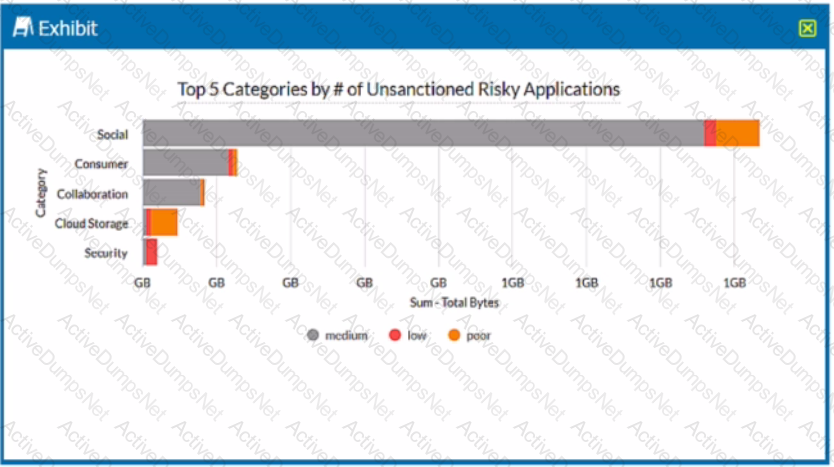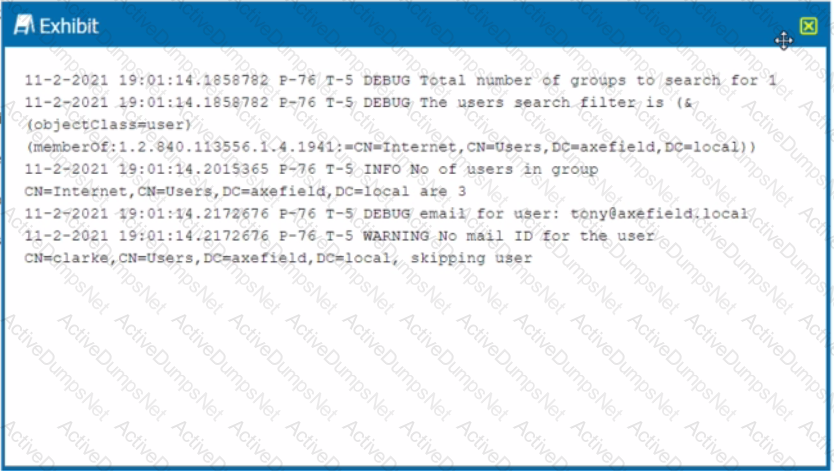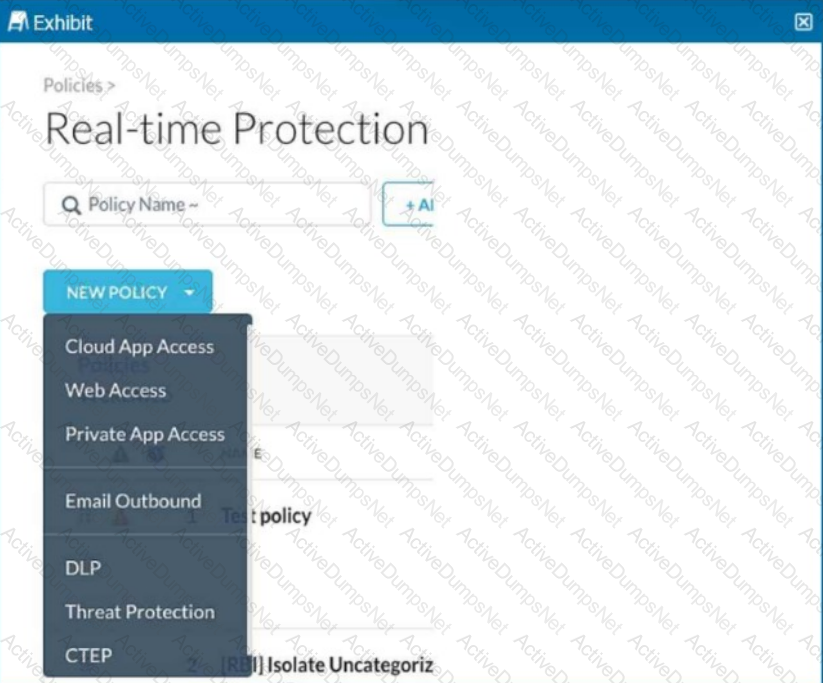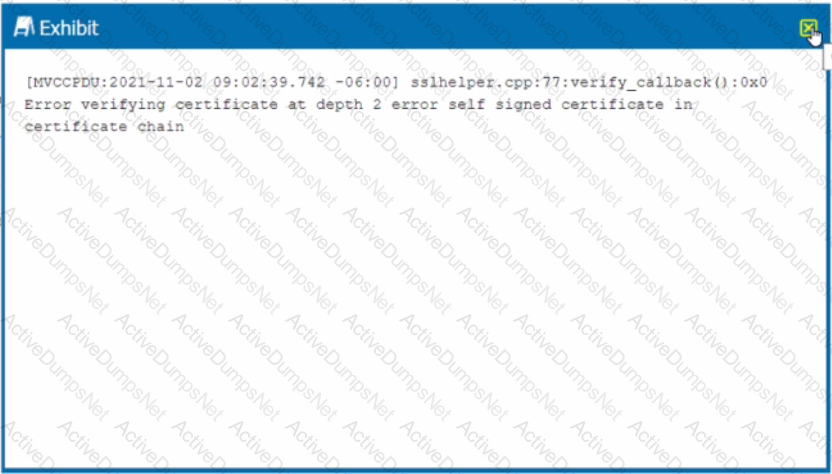Review the exhibit.
add log-upload syslogng parserconfig set log-upload syslogng parserconfig 0
logsource <log-source>
You are asked to deploy a virtual appliance OPLP to accept syslog messages directly from the enterprise Palo Alto Networks firewall. You believe that you have configured the OPLP to accept the firewall logs, yet they are not appearing in Risk Insights. Referring to the exhibit, which parser name would be required to complete the new configuration?
Review the exhibit.

You are asked to restrict users from accessing YouTube content tagged as Sport. You created the required real-time policy; however, users can still access the content
Referring to the exhibit, what is the problem?
Review the exhibit.

Your company uses Google as the corporate collaboration suite; however, corporate policy restricts the use of personal Google services. The exhibit provides a partially completed policy to ensure that users cannot log into their personal account.
What should be added to achieve the desired outcome in this scenario?
You are deploying a Netskope client in your corporate office network. You are aware of firewall or proxy rules that need to be modified to allow traffic.
Which two statements are true in this scenario? (Choose two.)
Review the exhibit.

Your Real-time Protection policy contains some rules with only a browse activity. The exhibit shows a new policy rule.
Where is the correct location to place this rule?
You use Netskope to provide a default Malware Scan profile for use with your malware policies. Also, you want to create a custom malware detection profile.
In this scenario, what are two additional requirements to complete this task? (Choose two.)
You are using the Netskope DLP solution. You notice that valid credit card numbers in a file that you just uploaded to an unsanctioned cloud storage solution are not triggering a policy violation. You can see the Skope IT application events for this traffic but no DLP alerts.
Which statement is correct in this scenario?
Review the exhibit.

A security analyst needs to create a report to view the top five categories of unsanctioned applications accessed in the last 90 days. Referring to the exhibit, what are two data collections in Advanced Analytics that would be used to create this report? (Choose two.)
Your customer has some managed Windows-based endpoints where they cannot add any clients or agents. For their users to have secure access to their SaaS application, you suggest that the customer use Netskope's Explicit Proxy.
Which two configurations are supported for this use case? (Choose two.)
Your customer implements Netskope Secure Web Gateway to secure all Web traffic. While they have created policies to block certain categories, there are many new sites available dally that are not yet categorized. The customer's users need quick access and cannot wait to put in a request to gain access requiring a policy change or have the site's category changed.
To solve this problem, which Netskope feature would provide quick, safe access to these types of sites?
Your company asks you to use Netskope to integrate with Endpoint Detection and Response (EDR) vendors such as Crowdstrike.
Which two requirements are needed for a successful integration and sharing of threat data? (Choose two.)
You are an administrator writing Netskope Real-time Protection policies and must determine proper policy ordering.
Which two statements are true in this scenario? (Choose two.)
You are provisioning Netskope users from Okta with SCIM Provisioning, and users are not showing up in the tenant. In this scenario, which two Netskope components should you verify first In Okta for accuracy? (Choose two.)
A customer wants to deploy the Netskope client on all their employee laptops to protect all Web traffic when users are working from home. However, users are required to work from their local offices at least one day per week. Management requests that users returning to the office be able to transparently leverage the local security stack without any user intervention.
Which two statements are correct in this scenario? (Choose two.)
Review the exhibit.

You are troubleshooting a Netskope client for user Clarke which remains in a disabled state after being installed. After looking at various logs, you notice something which might explain the problem. The exhibit is an excerpt from the nsADImporterLog.log.
Referring to the exhibit, what is the problem?
You are using the Netskope DLP solution. You notice flies containing test data for credit cards are not triggering DLP events when uploaded to Dropbox. There are corresponding page events. Which two scenarios would cause this behavior? (Choose two.)
After deploying the Netskope client to a number of devices, users report that the Client status indicates "Admin Disabled". User and gateway information is displayed correctly in the client configuration dialog
Why are clients installing in an "Admin Disabled" state in this scenario?
An engineering firm is using Netskope DLP to identify and block sensitive documents, including schematics and drawings. Lately, they have identified that when these documents are blocked, certain employees may be taking screenshots and uploading them. They want to block any screenshots from being uploaded.
Which feature would you use to satisfy this requirement?
Which statement describes how Netskope's REST API, v1 and v2, handles authentication?
Your customer currently only allows users to access the corporate instance of OneDrive using SSO with the Netskope client. The users are not permitted to take their laptops when vacationing, but sometimes they must have access to documents on OneDrive when there is an urgent request. The customer wants to allow employees to remotely access OneDrive from unmanaged devices while enforcing DLP controls to prohibit downloading sensitive files to unmanaged devices.
Which steering method would satisfy the requirements for this scenario?
You are having issues with fetching user and group Information periodically from the domain controller and posting that information to your tenant instance in the Netskope cloud. To begin the troubleshooting process, what would you Investigate first in this situation?
You are asked to grant access for a group of users to an application using NPA. So far, you have created and deployed the publisher and created a private application using the Netskope console.
Which two steps must also be completed to enable your users access to the application? (Choose two.)
You want to secure Microsoft Exchange and Gmail SMTP traffic for DLP using Netskope. Which statement is true about this scenario when using the Netskope client?
Review the exhibit.

What is the purpose of the configuration page shown Ii the exhibit?
Review the exhibit.

You are asked to create a new Real-time Protection policy to scan SMTP emails using data loss prevention (DLP) for personal health information (PHI). The scope is limited to only emails being sent from Microsoft Exchange Online to outside recipients.
Review the exhibit.

While diagnosing an NPA connectivity issue, you notice an error message in the Netskope client logs.
Referring to the exhibit, what does this error represent?
Review the exhibit.

You receive a service request from a user who indicates that their Netskope client is in a disabled state. The exhibit shows an excerpt (rom the affected client nsdebuglog.log.
What is the problem in this scenario?